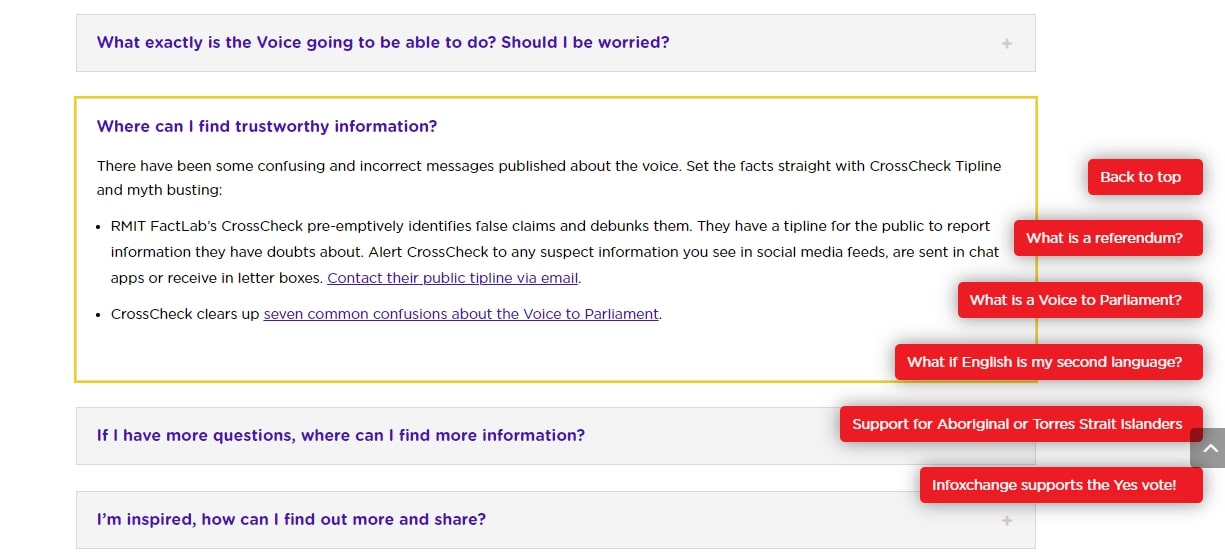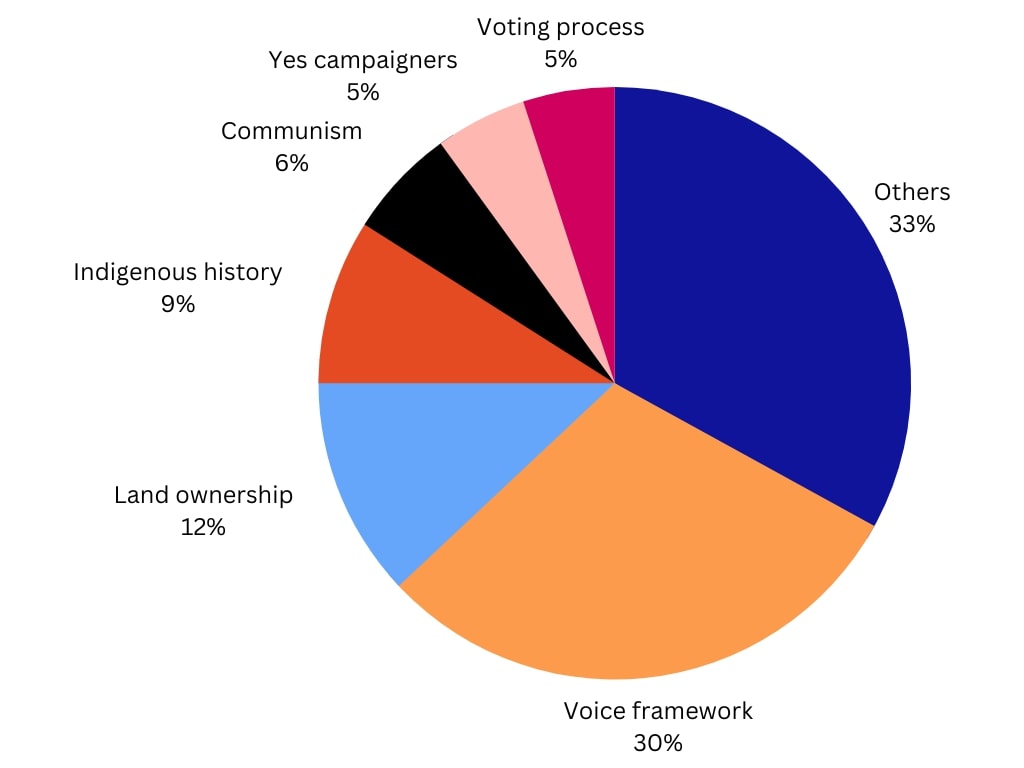
Tipline reveals need for Voice misinformation interventions
CrossCheck launched a pilot project to ask Australians what kind of referendum misinformation and disinformation they were facing, and tips came in almost every day.
By Esther Chan
Introduction
Going into the referendum cycle this year, CrossCheck’s team of disinformation researchers were hard at work prebunking and helping inoculate the public by promoting corrective information on the Voice and boosting media literacy.
We were, however, acutely aware of a missing piece of the puzzle. While researching online gave us access to a vast dataset of dubious claims about the Voice to Parliament proposal, we wanted a more comprehensive view of the kind of narratives bothering voters, especially those who were not in the habit of posting on social media.
Then there was the trend of factcheckers and disinformation researchers being questioned over how they could make sure they were unbiased while choosing what to factcheck and analyse.
We had an idea.
CrossCheck would create a direct line of communication so that our audience could send us tips. In this project we would not be the one handpicking content to factcheck, and our social listening capabilities would be expanded beyond social media platforms.
These tips would also inform our B2B style service which offers guidance to a diverse array of journalists across all reaches of Australia, as explained below.
Our tipline was born.
The result was impressive. With limited staff, minimal promotion and not being affiliated with any established news brand in Australia, we received a tip almost every day on average in the four months we ran the tipline.
The frequency of emails and claims highlights a glaring gap between the help people need to counter misinformation, and the supply of debunks, explainers and resources to meet that demand.
We will discuss this, as well as the methodology, findings and significance of our tipline project, in the following sections.
Methodology
First, we created a confidential, dedicated email address in RMIT University’s domain for the tipline. Tips sent to this address, including emails and any files attached, were protected by the enhanced security functions of Office 365.
The email address was then promoted through CheckMate, a newsletter addressing the latest trends in factchecking and misinformation under a partnership between RMIT and the ABC.
The tipline was also promoted by our team members during media interviews and linked to the Ask Izzy web portal, which connects people in need with relevant support services and caters for diverse language groups.
 Screenshot supplied by Ask Izzy showing CrossCheck’s tipline on the platform.
Screenshot supplied by Ask Izzy showing CrossCheck’s tipline on the platform.
Our commitment to the audience is that every tip would be examined by our researchers according to the following criteria:
- Does it present a piece of misinformation?
- Is it false, misleading, inaccurate, incomplete etc, or is it an opinion or a joke?
- Is the piece of misinformation related to the Voice?
- How widespread is the claim on social media?
- What is its impact on the referendum and/or the information ecosystem, and is a particular community targeted?
- Are there any existing factcheck reports or resources we can point to?
- If not, does the claim warrant further investigation?
Each claim was then categorised and recorded in a spreadsheet and any files attached to the emails were documented in a drive.
Depending on the type of tips – requests for our researchers to investigate a dubious claim, misunderstanding or misinterpretation of the Voice proposals, etc. – in response we supplied our audience with independent research, shared existing factcheck or news reports, and directed them to media literacy materials. This is because apart from helping debunk false or misleading claims, through the tipline we also aimed to inoculate our audience against misinformation.
Results
In the four months leading up to the referendum, we received a total of 110 tips, which were assessed and addressed by our researchers.
These insights not only enriched our understanding of Voice misinformation, but also informed our research into the disinformation landscape and facilitated our collaboration with journalists.
As we got closer to voting day, we started sending exclusive weekly reports to our media partners from the ABC, the Australian Community Media, Crikey, The Guardian, SBS and NITV detailing trends and narratives we learned from our audience.
Findings
The narratives that appeared most frequently in the tips and the percentage breakdown are as follows:

The key claims that fed into these narratives are documented below:
| Tipline Queries | Key Claims |
|---|---|
| Voice framework | Will the Voice lead to treaty/reparations/rent payment to indigineous people? Don't they already have a voice through government agencies and Indigenous MPs? |
| Land ownership | Is the Voice part of a UN agenda to asset-strip Australia? Is it a land grab? Is part of a WEF takeover? |
| Indigenous history | Are Aboriginal Australians the oldest civilisation in the world? Were they excluded from the census until the 1967 referendum? |
| Communism | Was the referendum working group formed by Communists? Are some of the Yes campaigners Communist? |
| Yes campaigners | Are Yes campaigners such as Marcia Langton or Thomas Mayo "indeed Indigenous"? |
| Voting process | Will a blank ballot count toward the Yes vote? Is there more than one question on the referendum ballot? |
| Others | Is enshrining an Indigenous Voice in the Constitution necessary for recognition? Is the Voice backed by 80% of Aboriginal and Torrest Strait Islander peoples? |
How Voice misinformation was spread, as told by our audience:
- Debunked claims continued to circulate
False or misleading narratives continued to circulate online despite being debunked multiple times by Australia-based factchecking organisations including AAP FactCheck, AFP Fact Check and RMIT FactLab, or addressed in explainers published by major news organisations or academics. - Voice misinformation was spreading offline via mailbox drops
Some of our audience sent us images of flyers and leaflets promoting Voice misinformation that they found in their mailboxes.
Noting that the factcheck reports and explainers mentioned in item 1 were for largely digital publications, this could mean online factchecks might not be effective in reaching people who get their news in print materials. - Mass emails still had an influence
Around 14 percent of our audience reported that claims had been sent to them by email, usually forwarded by a friend.
The emails, often touting purported “secret agenda[s]” of the Voice, originated from a mix of MP mailing lists, campaign groups, or unknown individuals.
While emails can seem a relic of pre-social media days, the number of mass or chain emails received by the tipline would suggest this form of digital communication as a means of sharing information is still going strong.
- Email newsletters were reaching non-subscribers
This corresponds with item 3 and refers to when a subscriber decided to forward an email newsletter that contained Voice misinformation to someone they knew. We learned from our audience that a lot of them did not sign up to these newsletters, which reached them anyway.
Some of these newsletters also found their way to non-subscribers via social media platforms, where portions of them were shared in the form of a screenshot or text post.
- Star power
Prominent political figures who advocated for the No case boosted the longevity and reach of certain narratives.
Names that kept coming up in the tips we received included Senator Jacinta Nampijinpa Price, who co-led the No campaign Fair Australia, as well as former Prime Minister Tony Abbott, who advised the conservative lobby group Advance.
Significance: what we’ve learned
With the tipline we hoped to achieve two things. First, improve our community listening and second, disrupt any of our own biases by committing to data submitted by our audience.
Interacting with our audience directly through email gave us incredible insights into what Voice misinformation the Australian public encountered on and offline in the lead-up to the referendum. We also got a better grasp of the claims that the public felt were unanswered and most concerning.
More often than not, the tips presented a question or concern about narratives that were clouding the Voice debate and distracting voters. In some cases, factcheck or news reports targeting a specific claim were already available online but somehow escaped our audience’s attention.
As discussed in the introduction, this project shone a light on the shortage of factchecked materials that were directly answering voters’ questions and quashing their doubts about the referendum.
On top of actively discovering misinformation during our work monitoring online narratives, in this project we took on a passive role in data collection and leaned on members of the public as a source of information.
Their tips widened the dimension of our work. The contextual information that substantiated the claims, namely how, when, where and from whom the piece of misinformation came about, helped us build a deeper understanding of what claims were out there and how they spread.
Regardless of the usual challenges of being a small team with limited resources which meant the undertaking was short-term and modest in scale, the tipline offered us a small but rich set of data that supplemented our online research into Voice misinformation.
Renee Davidson and Eiddwen Jeffery contributed to this report.


Acknowledgement of Country
RMIT University acknowledges the people of the Woi wurrung and Boon wurrung language groups of the eastern Kulin Nation on whose unceded lands we conduct the business of the University. RMIT University respectfully acknowledges their Ancestors and Elders, past and present. RMIT also acknowledges the Traditional Custodians and their Ancestors of the lands and waters across Australia where we conduct our business - Artwork 'Sentient' by Hollie Johnson, Gunaikurnai and Monero Ngarigo.
More information